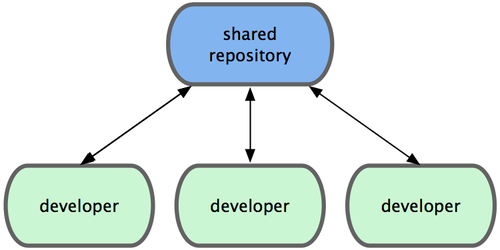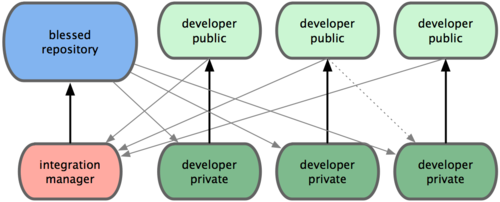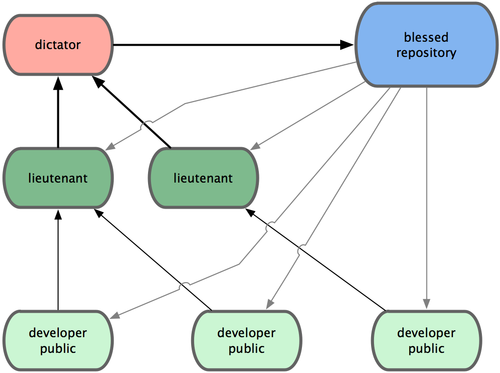Distributed Workflows
Unlike Centralized Version Control Systems (CVCSs), the distributed nature of Git allows you to be far more flexible in how developers collaborate on projects. In centralized systems, every developer is a node working more or less equally on a central hub. In Git, however, every developer is potentially both a node and a hub — that is, every developer can both contribute code to other repositories and maintain a public repository on which others can base their work and which they can contribute to. This opens a vast range of workflow possibilities for your project and/or your team, so I’ll cover a few common paradigms that take advantage of this flexibility. I’ll go over the strengths and possible weaknesses of each design; you can choose a single one to use, or you can mix and match features from each.
Centralized Workflow
In centralized systems, there is generally a single collaboration model—the centralized workflow. One central hub, or repository, can accept code, and everyone synchronizes their work to it. A number of developers are nodes — consumers of that hub — and synchronize to that one place (see Figure 5-1).
 Figure 5-1. Centralized workflow.
Figure 5-1. Centralized workflow.
This means that if two developers clone from the hub and both make changes, the first developer to push their changes back up can do so with no problems. The second developer must merge in the first one’s work before pushing changes up, so as not to overwrite the first developer’s changes. This concept is true in Git as it is in Subversion (or any CVCS), and this model works perfectly in Git.
If you have a small team or are already comfortable with a centralized workflow in your company or team, you can easily continue using that workflow with Git. Simply set up a single repository, and give everyone on your team push access; Git won’t let users overwrite each other. If one developer clones, makes changes, and then tries to push their changes while another developer has pushed in the meantime, the server will reject that developer’s changes. They will be told that they’re trying to push non-fast-forward changes and that they won’t be able to do so until they fetch and merge. This workflow is attractive to a lot of people because it’s a paradigm that many are familiar and comfortable with.
Integration-Manager Workflow
Because Git allows you to have multiple remote repositories, it’s possible to have a workflow where each developer has write access to their own public repository and read access to everyone else’s. This scenario often includes a canonical repository that represents the "official" project. To contribute to that project, you create your own public clone of the project and push your changes to it. Then, you can send a request to the maintainer of the main project to pull in your changes. They can add your repository as a remote, test your changes locally, merge them into their branch, and push back to their repository. The process works as follows (see Figure 5-2):
- The project maintainer pushes to their public repository.
- A contributor clones that repository and makes changes.
- The contributor pushes to their own public copy.
- The contributor sends the maintainer an e-mail asking them to pull changes.
- The maintainer adds the contributor’s repo as a remote and merges locally.
- The maintainer pushes merged changes to the main repository.
 Figure 5-2. Integration-manager workflow.
Figure 5-2. Integration-manager workflow.
This is a very common workflow with sites like GitHub, where it’s easy to fork a project and push your changes into your fork for everyone to see. One of the main advantages of this approach is that you can continue to work, and the maintainer of the main repository can pull in your changes at any time. Contributors don’t have to wait for the project to incorporate their changes — each party can work at their own pace.
Dictator and Lieutenants Workflow
This is a variant of a multiple-repository workflow. It’s generally used by huge projects with hundreds of collaborators; one famous example is the Linux kernel. Various integration managers are in charge of certain parts of the repository; they’re called lieutenants. All the lieutenants have one integration manager known as the benevolent dictator. The benevolent dictator’s repository serves as the reference repository from which all the collaborators need to pull. The process works like this (see Figure 5-3):
- Regular developers work on their topic branch and rebase their work on top of master. The master branch is that of the dictator.
- Lieutenants merge the developers’ topic branches into their master branch.
- The dictator merges the lieutenants’ master branches into the dictator’s master branch.
- The dictator pushes their master to the reference repository so the other developers can rebase on it.
 Figure 5-3. Benevolent dictator workflow.
Figure 5-3. Benevolent dictator workflow.
This kind of workflow isn’t common but can be useful in very big projects or in highly hierarchical environments, as it allows the project leader (the dictator) to delegate much of the work and collect large subsets of code at multiple points before integrating them.
These are some commonly used workflows that are possible with a distributed system like Git, but you can see that many variations are possible to suit your particular real-world workflow. Now that you can (I hope) determine which workflow combination may work for you, I’ll cover some more specific examples of how to accomplish the main roles that make up the different flows.
